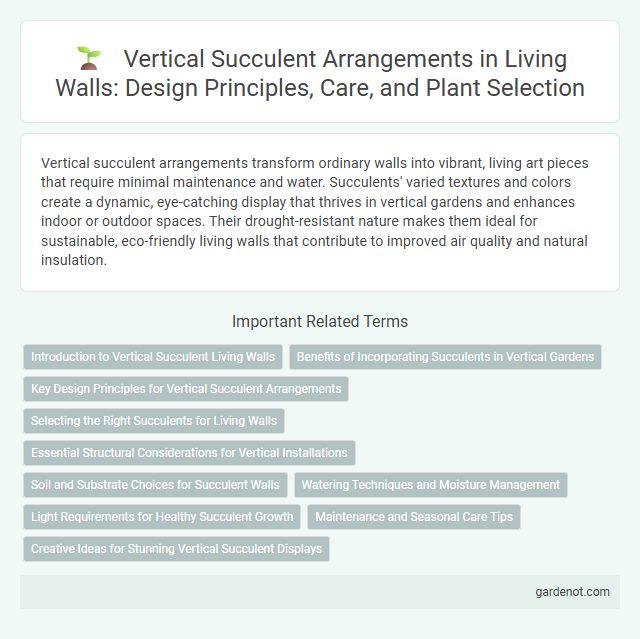Vertical succulent arrangements transform ordinary walls into vibrant, living art pieces that require minimal maintenance and water. Succulents' varied textures and colors create a dynamic, eye-catching display that thrives in vertical gardens and enhances indoor or outdoor spaces. Their drought-resistant nature makes them ideal for sustainable, eco-friendly living walls that contribute to improved air quality and natural insulation.
Introduction to Vertical Succulent Living Walls
Vertical succulent living walls feature low-maintenance plants arranged in a vertical structure, maximizing space while enhancing indoor or outdoor aesthetics. These walls utilize succulents' drought-resistant properties to create eco-friendly installations that improve air quality and reduce noise pollution. Vertical succulent arrangements offer versatile design options, combining texture, color, and form to transform spaces into vibrant, sustainable environments.
Benefits of Incorporating Succulents in Vertical Gardens
Vertical succulent arrangements enhance indoor air quality by increasing oxygen levels and filtering toxins. Their drought-resistant nature reduces water consumption, making them ideal for sustainable vertical gardens. Succulents also add aesthetic appeal through diverse textures and colors, promoting stress reduction and well-being in living spaces.
Key Design Principles for Vertical Succulent Arrangements
Vertical succulent arrangements thrive on selecting drought-tolerant species with varied textures and colors to create visual interest while ensuring easy maintenance. Proper soil composition and drainage are crucial to prevent root rot and promote healthy growth in vertical planters. Strategic placement of succulents considering light exposure and spacing optimizes air circulation and overall plant vitality in living wall designs.
Selecting the Right Succulents for Living Walls
Choosing the right succulents for living walls involves prioritizing species with shallow root systems and high drought tolerance, such as Echeveria, Sedum, and Crassula. These succulents thrive in vertical arrangements due to their low water needs and adaptability to limited soil depth. Proper selection ensures a sustainable, low-maintenance vertical garden that maintains vibrant color and texture throughout all seasons.
Essential Structural Considerations for Vertical Installations
Vertical succulent arrangements require a sturdy backing material such as plywood or metal mesh to support the weight of the plants and growing medium. Proper drainage systems like waterproof liners and drip irrigation prevent water accumulation and root rot, ensuring plant health. Lightweight, well-aerated soil mixtures tailored for succulents enhance moisture retention and provide stability for vertical growth.
Soil and Substrate Choices for Succulent Walls
Choosing the right soil and substrate is critical for vertical succulent arrangements to ensure proper drainage and root aeration. A well-draining mix typically combines coarse sand, perlite, and organic matter like coconut coir or peat moss to prevent water retention that causes root rot. Using lightweight substrates supports the vertical structure while maintaining moisture balance ideal for succulents' drought-resistant nature.
Watering Techniques and Moisture Management
Vertical succulent arrangements require precise watering techniques to prevent root rot and ensure optimal moisture levels. Use a drip irrigation system or carefully timed misting to deliver water directly to the base of each succulent, avoiding excess moisture on leaves. Incorporate well-draining substrates like cactus soil mix and monitor humidity with moisture sensors for efficient moisture management and healthy growth.
Light Requirements for Healthy Succulent Growth
Vertical succulent arrangements thrive in bright, indirect light, requiring at least six hours of sunlight daily to maintain vibrant colors and compact growth. Insufficient light leads to etiolation, causing succulents to become leggy and weak. Positioning the living wall near south- or east-facing windows maximizes natural light exposure essential for healthy photosynthesis and water regulation.
Maintenance and Seasonal Care Tips
Maintaining a vertical succulent arrangement requires careful watering practices to prevent root rot, ideally watering every 2-3 weeks depending on indoor humidity and temperature. Seasonal care includes reducing watering frequency during winter dormancy and ensuring adequate light exposure to support healthy growth without sunburn. Regularly inspect for pests and remove dead leaves to promote airflow and prevent fungal infections.
Creative Ideas for Stunning Vertical Succulent Displays
Vertical succulent arrangements transform blank walls into living art with creative ideas such as geometric patterns, mixed textures, and varied succulent species for a dynamic visual appeal. Using modular planter systems or repurposed frames enhances accessibility and design flexibility, allowing intricate layering and color contrast that highlights each succulent's unique form. Incorporating LED grow lights and automated drip irrigation optimizes growth conditions, ensuring these stunning vertical displays thrive in both indoor and outdoor settings.
Vertical succulent arrangement Infographic

 gardenot.com
gardenot.com